Systems Thinking Report: Analyzing Business Processes for Optimization
VerifiedAdded on 2022/10/01
|13
|3100
|424
Report
AI Summary
This report provides an analysis of systems thinking tools and their application in integrating, optimizing, and enhancing business processes within contemporary organizations. It begins with an executive summary highlighting the increasing complexity of modern business environments and the role of technology, particularly Business Process Models (BPM), in addressing these challenges. The report explores various BPM notations, with a focus on Business Process Modeling Notation (BPMN), and classifies BPM tools based on their functions, such as workflow, activity-based costing, and data flow diagrams. It discusses how these tools improve communication, efficiency, operation alignment, and competitiveness. Furthermore, the report examines both technological and non-technological solutions to common business problems, including uncertainty, financial management, performance monitoring, reputation management, and customer service. Technological solutions, such as computerization, disaster management systems, data security, and remote working capabilities, are explored. The report also emphasizes the importance of non-technological solutions, such as effective employee recruitment and communication strategies. The conclusion reinforces the importance of systems thinking and the integration of technological and non-technological approaches to achieve business success. The report concludes with recommendations for organizations to improve their business processes and overall performance.

Running Head: SYSTEMS THINKING 1
SYSTEMS THINKING
Student’s Name
Professor’s Name
Course
Date
SYSTEMS THINKING
Student’s Name
Professor’s Name
Course
Date
Paraphrase This Document
Need a fresh take? Get an instant paraphrase of this document with our AI Paraphraser
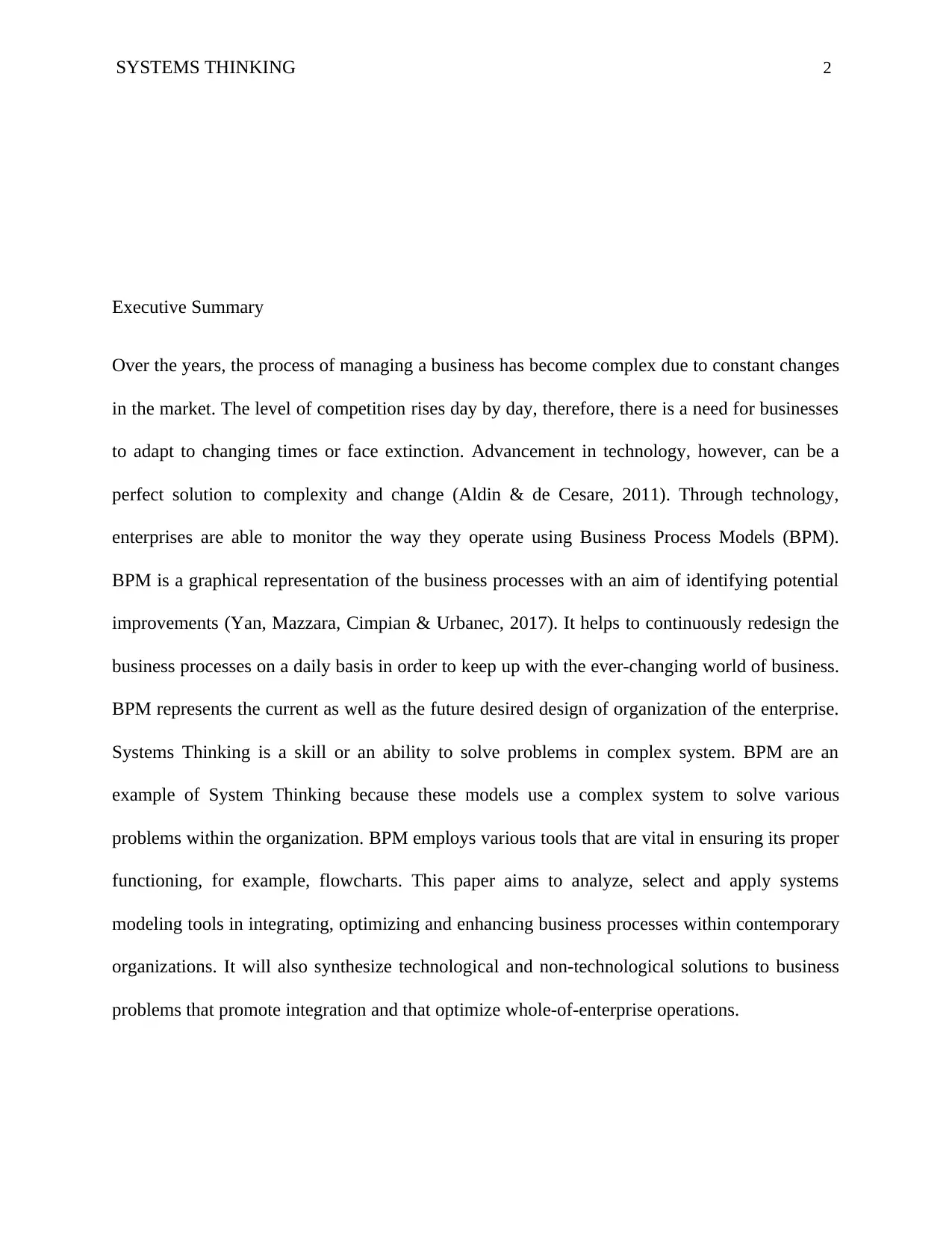
SYSTEMS THINKING 2
Executive Summary
Over the years, the process of managing a business has become complex due to constant changes
in the market. The level of competition rises day by day, therefore, there is a need for businesses
to adapt to changing times or face extinction. Advancement in technology, however, can be a
perfect solution to complexity and change (Aldin & de Cesare, 2011). Through technology,
enterprises are able to monitor the way they operate using Business Process Models (BPM).
BPM is a graphical representation of the business processes with an aim of identifying potential
improvements (Yan, Mazzara, Cimpian & Urbanec, 2017). It helps to continuously redesign the
business processes on a daily basis in order to keep up with the ever-changing world of business.
BPM represents the current as well as the future desired design of organization of the enterprise.
Systems Thinking is a skill or an ability to solve problems in complex system. BPM are an
example of System Thinking because these models use a complex system to solve various
problems within the organization. BPM employs various tools that are vital in ensuring its proper
functioning, for example, flowcharts. This paper aims to analyze, select and apply systems
modeling tools in integrating, optimizing and enhancing business processes within contemporary
organizations. It will also synthesize technological and non-technological solutions to business
problems that promote integration and that optimize whole-of-enterprise operations.
Executive Summary
Over the years, the process of managing a business has become complex due to constant changes
in the market. The level of competition rises day by day, therefore, there is a need for businesses
to adapt to changing times or face extinction. Advancement in technology, however, can be a
perfect solution to complexity and change (Aldin & de Cesare, 2011). Through technology,
enterprises are able to monitor the way they operate using Business Process Models (BPM).
BPM is a graphical representation of the business processes with an aim of identifying potential
improvements (Yan, Mazzara, Cimpian & Urbanec, 2017). It helps to continuously redesign the
business processes on a daily basis in order to keep up with the ever-changing world of business.
BPM represents the current as well as the future desired design of organization of the enterprise.
Systems Thinking is a skill or an ability to solve problems in complex system. BPM are an
example of System Thinking because these models use a complex system to solve various
problems within the organization. BPM employs various tools that are vital in ensuring its proper
functioning, for example, flowcharts. This paper aims to analyze, select and apply systems
modeling tools in integrating, optimizing and enhancing business processes within contemporary
organizations. It will also synthesize technological and non-technological solutions to business
problems that promote integration and that optimize whole-of-enterprise operations.
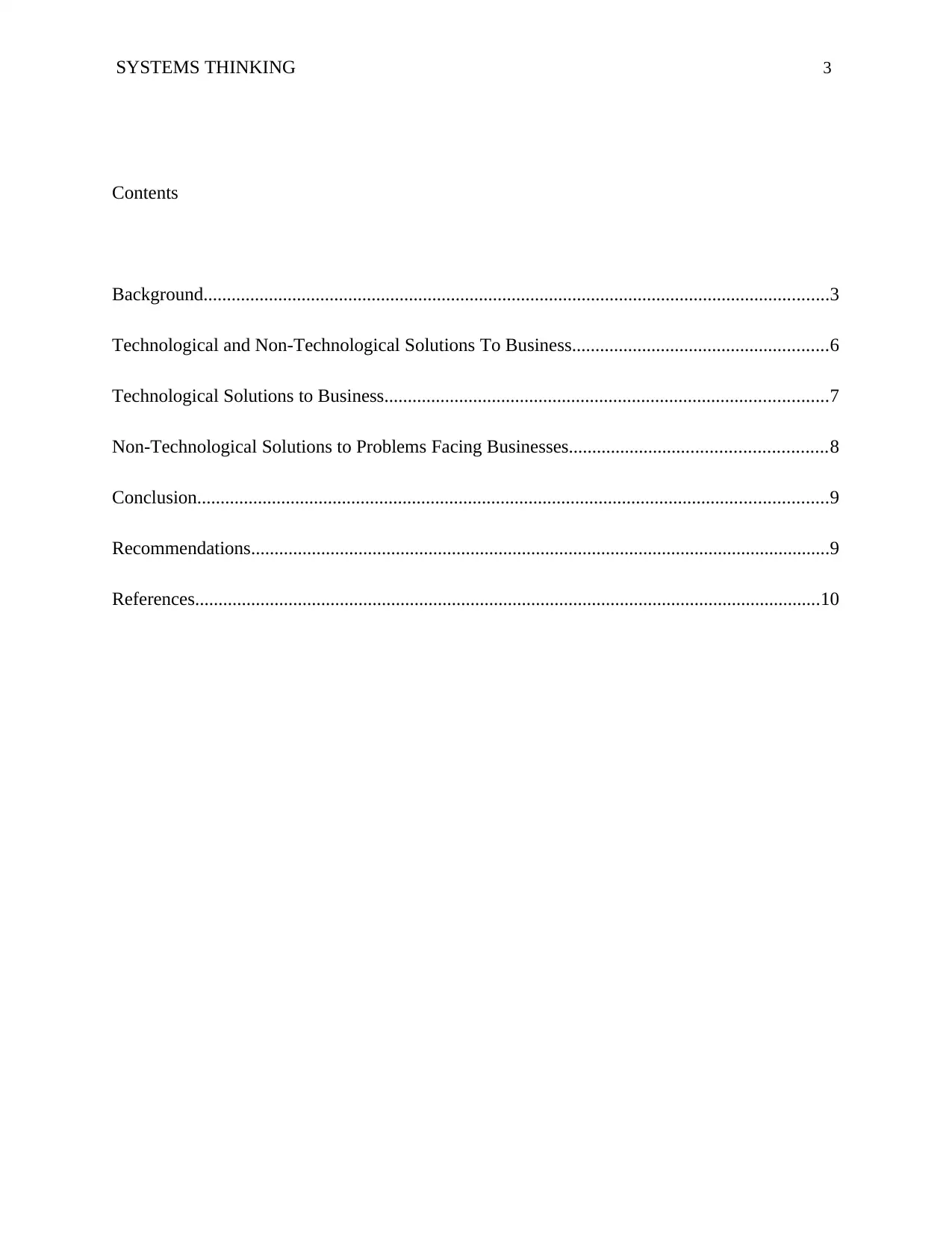
SYSTEMS THINKING 3
Contents
Background......................................................................................................................................3
Technological and Non-Technological Solutions To Business.......................................................6
Technological Solutions to Business...............................................................................................7
Non-Technological Solutions to Problems Facing Businesses.......................................................8
Conclusion.......................................................................................................................................9
Recommendations............................................................................................................................9
References......................................................................................................................................10
Contents
Background......................................................................................................................................3
Technological and Non-Technological Solutions To Business.......................................................6
Technological Solutions to Business...............................................................................................7
Non-Technological Solutions to Problems Facing Businesses.......................................................8
Conclusion.......................................................................................................................................9
Recommendations............................................................................................................................9
References......................................................................................................................................10
⊘ This is a preview!⊘
Do you want full access?
Subscribe today to unlock all pages.

Trusted by 1+ million students worldwide
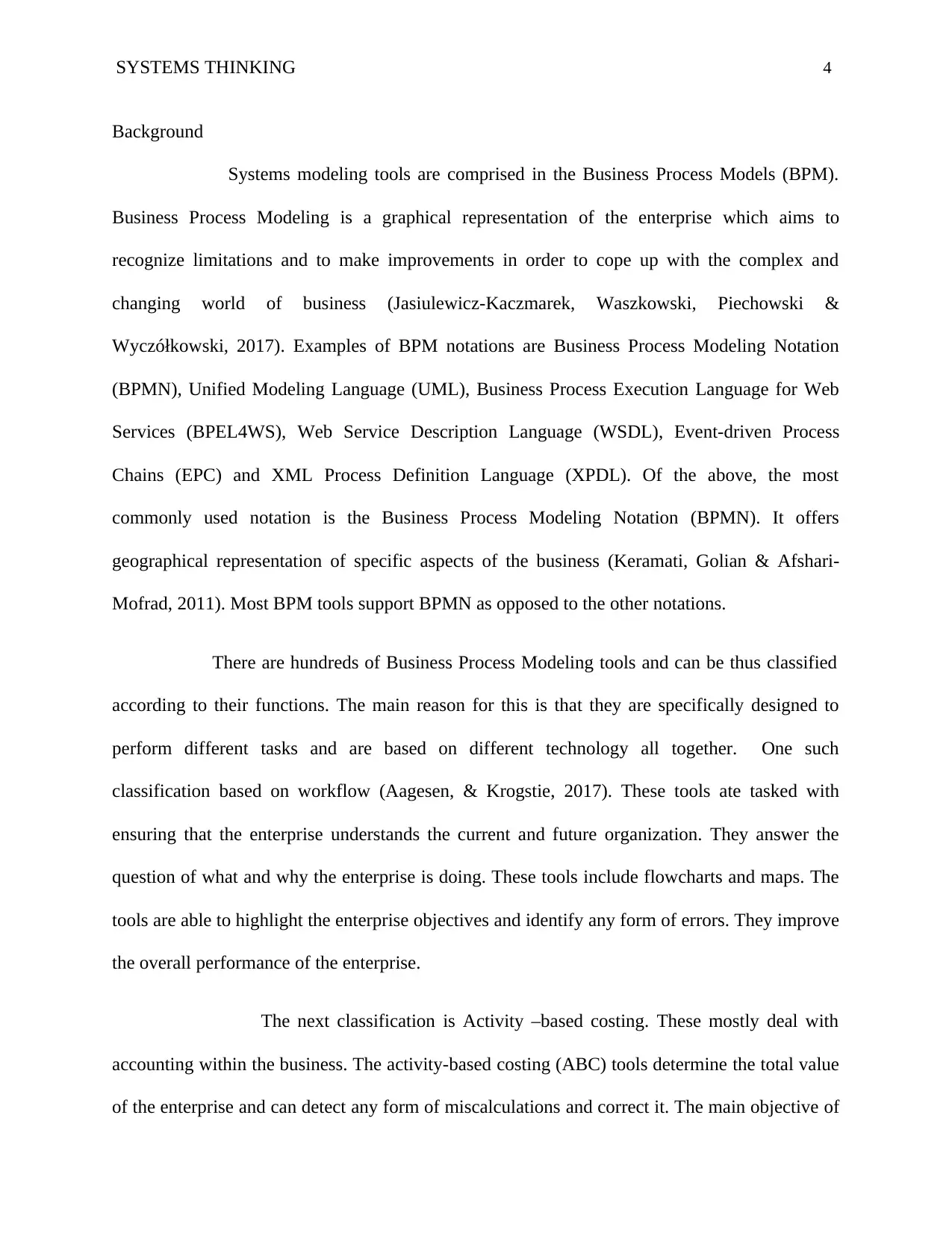
SYSTEMS THINKING 4
Background
Systems modeling tools are comprised in the Business Process Models (BPM).
Business Process Modeling is a graphical representation of the enterprise which aims to
recognize limitations and to make improvements in order to cope up with the complex and
changing world of business (Jasiulewicz-Kaczmarek, Waszkowski, Piechowski &
Wyczółkowski, 2017). Examples of BPM notations are Business Process Modeling Notation
(BPMN), Unified Modeling Language (UML), Business Process Execution Language for Web
Services (BPEL4WS), Web Service Description Language (WSDL), Event-driven Process
Chains (EPC) and XML Process Definition Language (XPDL). Of the above, the most
commonly used notation is the Business Process Modeling Notation (BPMN). It offers
geographical representation of specific aspects of the business (Keramati, Golian & Afshari-
Mofrad, 2011). Most BPM tools support BPMN as opposed to the other notations.
There are hundreds of Business Process Modeling tools and can be thus classified
according to their functions. The main reason for this is that they are specifically designed to
perform different tasks and are based on different technology all together. One such
classification based on workflow (Aagesen, & Krogstie, 2017). These tools ate tasked with
ensuring that the enterprise understands the current and future organization. They answer the
question of what and why the enterprise is doing. These tools include flowcharts and maps. The
tools are able to highlight the enterprise objectives and identify any form of errors. They improve
the overall performance of the enterprise.
The next classification is Activity –based costing. These mostly deal with
accounting within the business. The activity-based costing (ABC) tools determine the total value
of the enterprise and can detect any form of miscalculations and correct it. The main objective of
Background
Systems modeling tools are comprised in the Business Process Models (BPM).
Business Process Modeling is a graphical representation of the enterprise which aims to
recognize limitations and to make improvements in order to cope up with the complex and
changing world of business (Jasiulewicz-Kaczmarek, Waszkowski, Piechowski &
Wyczółkowski, 2017). Examples of BPM notations are Business Process Modeling Notation
(BPMN), Unified Modeling Language (UML), Business Process Execution Language for Web
Services (BPEL4WS), Web Service Description Language (WSDL), Event-driven Process
Chains (EPC) and XML Process Definition Language (XPDL). Of the above, the most
commonly used notation is the Business Process Modeling Notation (BPMN). It offers
geographical representation of specific aspects of the business (Keramati, Golian & Afshari-
Mofrad, 2011). Most BPM tools support BPMN as opposed to the other notations.
There are hundreds of Business Process Modeling tools and can be thus classified
according to their functions. The main reason for this is that they are specifically designed to
perform different tasks and are based on different technology all together. One such
classification based on workflow (Aagesen, & Krogstie, 2017). These tools ate tasked with
ensuring that the enterprise understands the current and future organization. They answer the
question of what and why the enterprise is doing. These tools include flowcharts and maps. The
tools are able to highlight the enterprise objectives and identify any form of errors. They improve
the overall performance of the enterprise.
The next classification is Activity –based costing. These mostly deal with
accounting within the business. The activity-based costing (ABC) tools determine the total value
of the enterprise and can detect any form of miscalculations and correct it. The main objective of
Paraphrase This Document
Need a fresh take? Get an instant paraphrase of this document with our AI Paraphraser
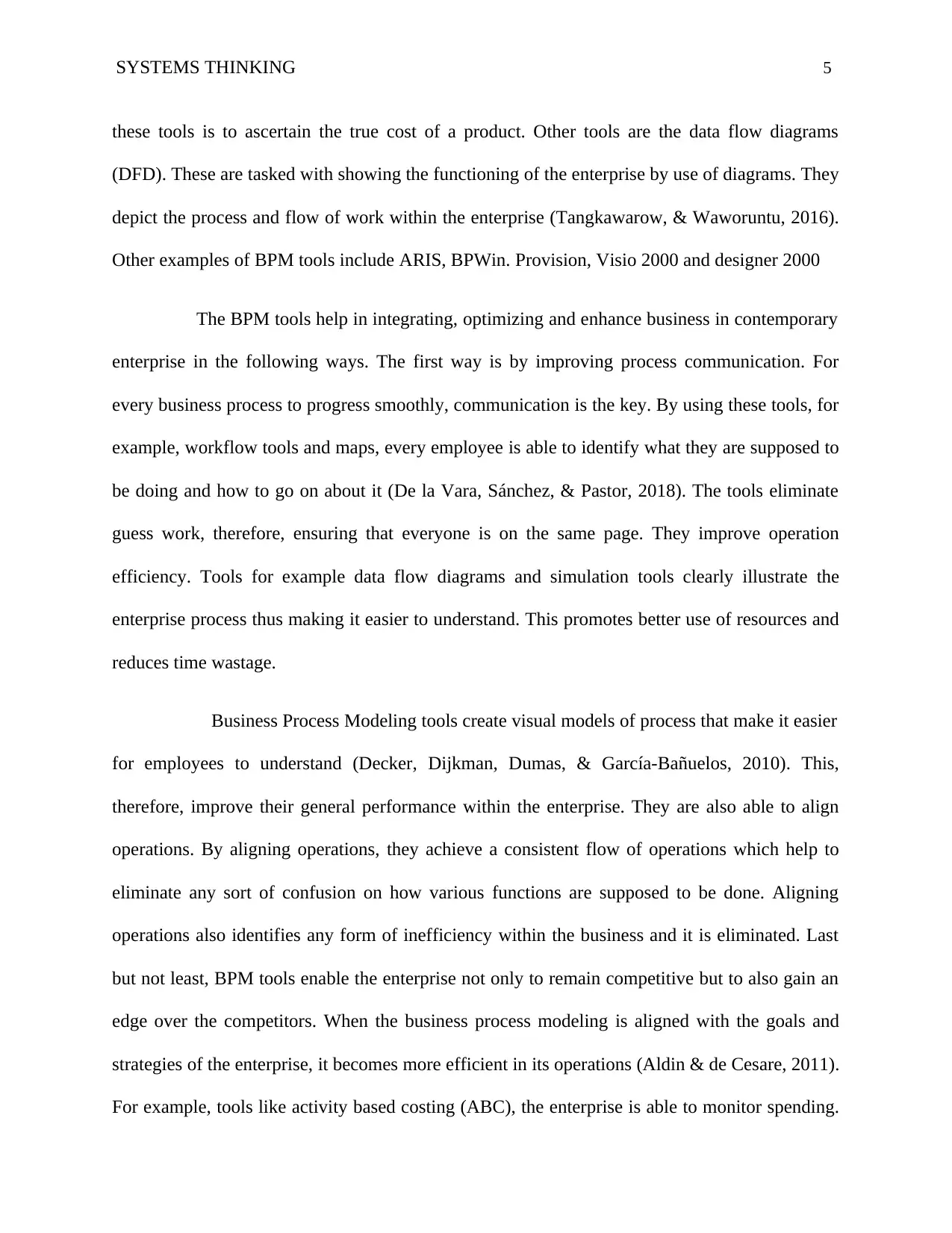
SYSTEMS THINKING 5
these tools is to ascertain the true cost of a product. Other tools are the data flow diagrams
(DFD). These are tasked with showing the functioning of the enterprise by use of diagrams. They
depict the process and flow of work within the enterprise (Tangkawarow, & Waworuntu, 2016).
Other examples of BPM tools include ARIS, BPWin. Provision, Visio 2000 and designer 2000
The BPM tools help in integrating, optimizing and enhance business in contemporary
enterprise in the following ways. The first way is by improving process communication. For
every business process to progress smoothly, communication is the key. By using these tools, for
example, workflow tools and maps, every employee is able to identify what they are supposed to
be doing and how to go on about it (De la Vara, Sánchez, & Pastor, 2018). The tools eliminate
guess work, therefore, ensuring that everyone is on the same page. They improve operation
efficiency. Tools for example data flow diagrams and simulation tools clearly illustrate the
enterprise process thus making it easier to understand. This promotes better use of resources and
reduces time wastage.
Business Process Modeling tools create visual models of process that make it easier
for employees to understand (Decker, Dijkman, Dumas, & García-Bañuelos, 2010). This,
therefore, improve their general performance within the enterprise. They are also able to align
operations. By aligning operations, they achieve a consistent flow of operations which help to
eliminate any sort of confusion on how various functions are supposed to be done. Aligning
operations also identifies any form of inefficiency within the business and it is eliminated. Last
but not least, BPM tools enable the enterprise not only to remain competitive but to also gain an
edge over the competitors. When the business process modeling is aligned with the goals and
strategies of the enterprise, it becomes more efficient in its operations (Aldin & de Cesare, 2011).
For example, tools like activity based costing (ABC), the enterprise is able to monitor spending.
these tools is to ascertain the true cost of a product. Other tools are the data flow diagrams
(DFD). These are tasked with showing the functioning of the enterprise by use of diagrams. They
depict the process and flow of work within the enterprise (Tangkawarow, & Waworuntu, 2016).
Other examples of BPM tools include ARIS, BPWin. Provision, Visio 2000 and designer 2000
The BPM tools help in integrating, optimizing and enhance business in contemporary
enterprise in the following ways. The first way is by improving process communication. For
every business process to progress smoothly, communication is the key. By using these tools, for
example, workflow tools and maps, every employee is able to identify what they are supposed to
be doing and how to go on about it (De la Vara, Sánchez, & Pastor, 2018). The tools eliminate
guess work, therefore, ensuring that everyone is on the same page. They improve operation
efficiency. Tools for example data flow diagrams and simulation tools clearly illustrate the
enterprise process thus making it easier to understand. This promotes better use of resources and
reduces time wastage.
Business Process Modeling tools create visual models of process that make it easier
for employees to understand (Decker, Dijkman, Dumas, & García-Bañuelos, 2010). This,
therefore, improve their general performance within the enterprise. They are also able to align
operations. By aligning operations, they achieve a consistent flow of operations which help to
eliminate any sort of confusion on how various functions are supposed to be done. Aligning
operations also identifies any form of inefficiency within the business and it is eliminated. Last
but not least, BPM tools enable the enterprise not only to remain competitive but to also gain an
edge over the competitors. When the business process modeling is aligned with the goals and
strategies of the enterprise, it becomes more efficient in its operations (Aldin & de Cesare, 2011).
For example, tools like activity based costing (ABC), the enterprise is able to monitor spending.
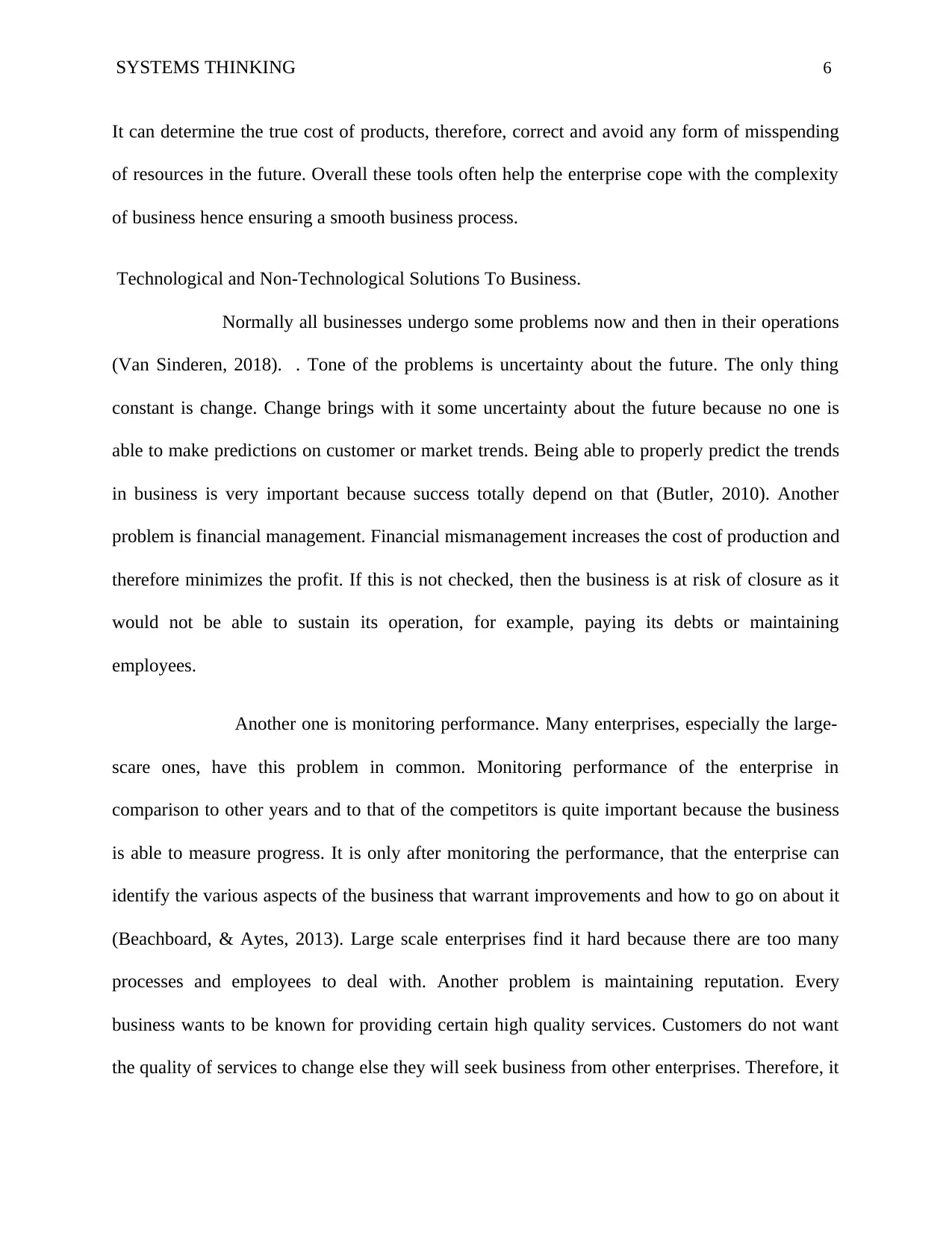
SYSTEMS THINKING 6
It can determine the true cost of products, therefore, correct and avoid any form of misspending
of resources in the future. Overall these tools often help the enterprise cope with the complexity
of business hence ensuring a smooth business process.
Technological and Non-Technological Solutions To Business.
Normally all businesses undergo some problems now and then in their operations
(Van Sinderen, 2018). . Tone of the problems is uncertainty about the future. The only thing
constant is change. Change brings with it some uncertainty about the future because no one is
able to make predictions on customer or market trends. Being able to properly predict the trends
in business is very important because success totally depend on that (Butler, 2010). Another
problem is financial management. Financial mismanagement increases the cost of production and
therefore minimizes the profit. If this is not checked, then the business is at risk of closure as it
would not be able to sustain its operation, for example, paying its debts or maintaining
employees.
Another one is monitoring performance. Many enterprises, especially the large-
scare ones, have this problem in common. Monitoring performance of the enterprise in
comparison to other years and to that of the competitors is quite important because the business
is able to measure progress. It is only after monitoring the performance, that the enterprise can
identify the various aspects of the business that warrant improvements and how to go on about it
(Beachboard, & Aytes, 2013). Large scale enterprises find it hard because there are too many
processes and employees to deal with. Another problem is maintaining reputation. Every
business wants to be known for providing certain high quality services. Customers do not want
the quality of services to change else they will seek business from other enterprises. Therefore, it
It can determine the true cost of products, therefore, correct and avoid any form of misspending
of resources in the future. Overall these tools often help the enterprise cope with the complexity
of business hence ensuring a smooth business process.
Technological and Non-Technological Solutions To Business.
Normally all businesses undergo some problems now and then in their operations
(Van Sinderen, 2018). . Tone of the problems is uncertainty about the future. The only thing
constant is change. Change brings with it some uncertainty about the future because no one is
able to make predictions on customer or market trends. Being able to properly predict the trends
in business is very important because success totally depend on that (Butler, 2010). Another
problem is financial management. Financial mismanagement increases the cost of production and
therefore minimizes the profit. If this is not checked, then the business is at risk of closure as it
would not be able to sustain its operation, for example, paying its debts or maintaining
employees.
Another one is monitoring performance. Many enterprises, especially the large-
scare ones, have this problem in common. Monitoring performance of the enterprise in
comparison to other years and to that of the competitors is quite important because the business
is able to measure progress. It is only after monitoring the performance, that the enterprise can
identify the various aspects of the business that warrant improvements and how to go on about it
(Beachboard, & Aytes, 2013). Large scale enterprises find it hard because there are too many
processes and employees to deal with. Another problem is maintaining reputation. Every
business wants to be known for providing certain high quality services. Customers do not want
the quality of services to change else they will seek business from other enterprises. Therefore, it
⊘ This is a preview!⊘
Do you want full access?
Subscribe today to unlock all pages.

Trusted by 1+ million students worldwide
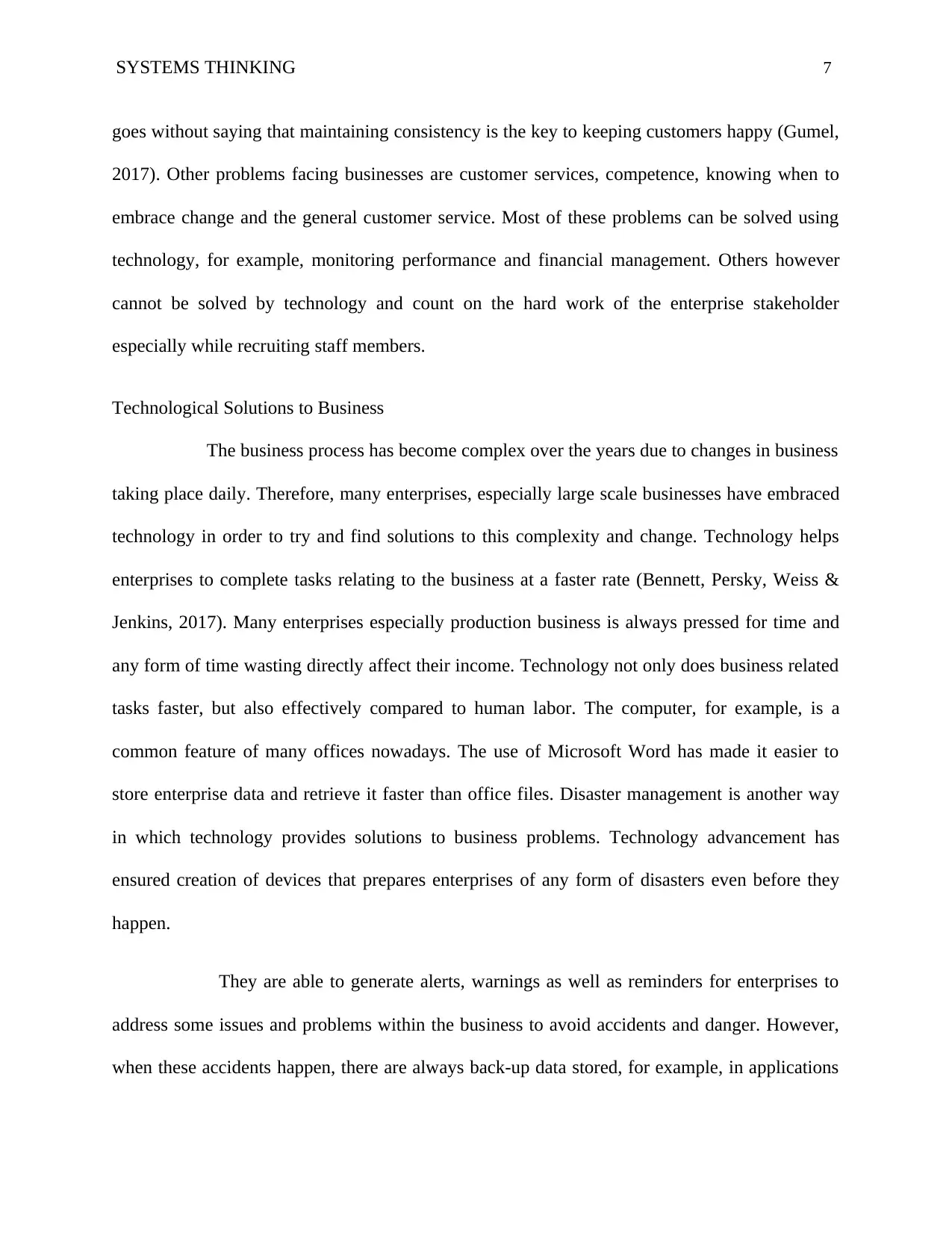
SYSTEMS THINKING 7
goes without saying that maintaining consistency is the key to keeping customers happy (Gumel,
2017). Other problems facing businesses are customer services, competence, knowing when to
embrace change and the general customer service. Most of these problems can be solved using
technology, for example, monitoring performance and financial management. Others however
cannot be solved by technology and count on the hard work of the enterprise stakeholder
especially while recruiting staff members.
Technological Solutions to Business
The business process has become complex over the years due to changes in business
taking place daily. Therefore, many enterprises, especially large scale businesses have embraced
technology in order to try and find solutions to this complexity and change. Technology helps
enterprises to complete tasks relating to the business at a faster rate (Bennett, Persky, Weiss &
Jenkins, 2017). Many enterprises especially production business is always pressed for time and
any form of time wasting directly affect their income. Technology not only does business related
tasks faster, but also effectively compared to human labor. The computer, for example, is a
common feature of many offices nowadays. The use of Microsoft Word has made it easier to
store enterprise data and retrieve it faster than office files. Disaster management is another way
in which technology provides solutions to business problems. Technology advancement has
ensured creation of devices that prepares enterprises of any form of disasters even before they
happen.
They are able to generate alerts, warnings as well as reminders for enterprises to
address some issues and problems within the business to avoid accidents and danger. However,
when these accidents happen, there are always back-up data stored, for example, in applications
goes without saying that maintaining consistency is the key to keeping customers happy (Gumel,
2017). Other problems facing businesses are customer services, competence, knowing when to
embrace change and the general customer service. Most of these problems can be solved using
technology, for example, monitoring performance and financial management. Others however
cannot be solved by technology and count on the hard work of the enterprise stakeholder
especially while recruiting staff members.
Technological Solutions to Business
The business process has become complex over the years due to changes in business
taking place daily. Therefore, many enterprises, especially large scale businesses have embraced
technology in order to try and find solutions to this complexity and change. Technology helps
enterprises to complete tasks relating to the business at a faster rate (Bennett, Persky, Weiss &
Jenkins, 2017). Many enterprises especially production business is always pressed for time and
any form of time wasting directly affect their income. Technology not only does business related
tasks faster, but also effectively compared to human labor. The computer, for example, is a
common feature of many offices nowadays. The use of Microsoft Word has made it easier to
store enterprise data and retrieve it faster than office files. Disaster management is another way
in which technology provides solutions to business problems. Technology advancement has
ensured creation of devices that prepares enterprises of any form of disasters even before they
happen.
They are able to generate alerts, warnings as well as reminders for enterprises to
address some issues and problems within the business to avoid accidents and danger. However,
when these accidents happen, there are always back-up data stored, for example, in applications
Paraphrase This Document
Need a fresh take? Get an instant paraphrase of this document with our AI Paraphraser
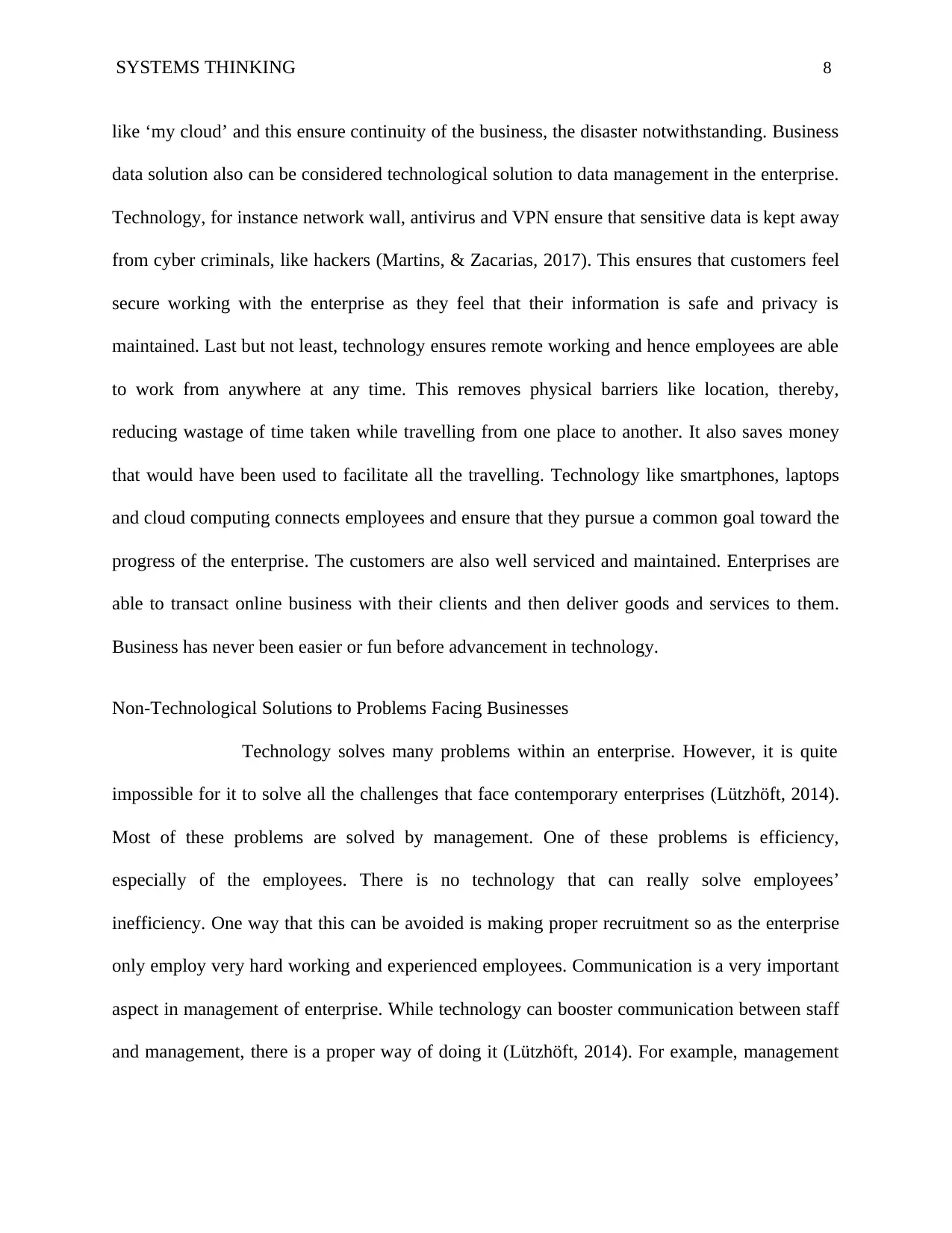
SYSTEMS THINKING 8
like ‘my cloud’ and this ensure continuity of the business, the disaster notwithstanding. Business
data solution also can be considered technological solution to data management in the enterprise.
Technology, for instance network wall, antivirus and VPN ensure that sensitive data is kept away
from cyber criminals, like hackers (Martins, & Zacarias, 2017). This ensures that customers feel
secure working with the enterprise as they feel that their information is safe and privacy is
maintained. Last but not least, technology ensures remote working and hence employees are able
to work from anywhere at any time. This removes physical barriers like location, thereby,
reducing wastage of time taken while travelling from one place to another. It also saves money
that would have been used to facilitate all the travelling. Technology like smartphones, laptops
and cloud computing connects employees and ensure that they pursue a common goal toward the
progress of the enterprise. The customers are also well serviced and maintained. Enterprises are
able to transact online business with their clients and then deliver goods and services to them.
Business has never been easier or fun before advancement in technology.
Non-Technological Solutions to Problems Facing Businesses
Technology solves many problems within an enterprise. However, it is quite
impossible for it to solve all the challenges that face contemporary enterprises (Lützhöft, 2014).
Most of these problems are solved by management. One of these problems is efficiency,
especially of the employees. There is no technology that can really solve employees’
inefficiency. One way that this can be avoided is making proper recruitment so as the enterprise
only employ very hard working and experienced employees. Communication is a very important
aspect in management of enterprise. While technology can booster communication between staff
and management, there is a proper way of doing it (Lützhöft, 2014). For example, management
like ‘my cloud’ and this ensure continuity of the business, the disaster notwithstanding. Business
data solution also can be considered technological solution to data management in the enterprise.
Technology, for instance network wall, antivirus and VPN ensure that sensitive data is kept away
from cyber criminals, like hackers (Martins, & Zacarias, 2017). This ensures that customers feel
secure working with the enterprise as they feel that their information is safe and privacy is
maintained. Last but not least, technology ensures remote working and hence employees are able
to work from anywhere at any time. This removes physical barriers like location, thereby,
reducing wastage of time taken while travelling from one place to another. It also saves money
that would have been used to facilitate all the travelling. Technology like smartphones, laptops
and cloud computing connects employees and ensure that they pursue a common goal toward the
progress of the enterprise. The customers are also well serviced and maintained. Enterprises are
able to transact online business with their clients and then deliver goods and services to them.
Business has never been easier or fun before advancement in technology.
Non-Technological Solutions to Problems Facing Businesses
Technology solves many problems within an enterprise. However, it is quite
impossible for it to solve all the challenges that face contemporary enterprises (Lützhöft, 2014).
Most of these problems are solved by management. One of these problems is efficiency,
especially of the employees. There is no technology that can really solve employees’
inefficiency. One way that this can be avoided is making proper recruitment so as the enterprise
only employ very hard working and experienced employees. Communication is a very important
aspect in management of enterprise. While technology can booster communication between staff
and management, there is a proper way of doing it (Lützhöft, 2014). For example, management
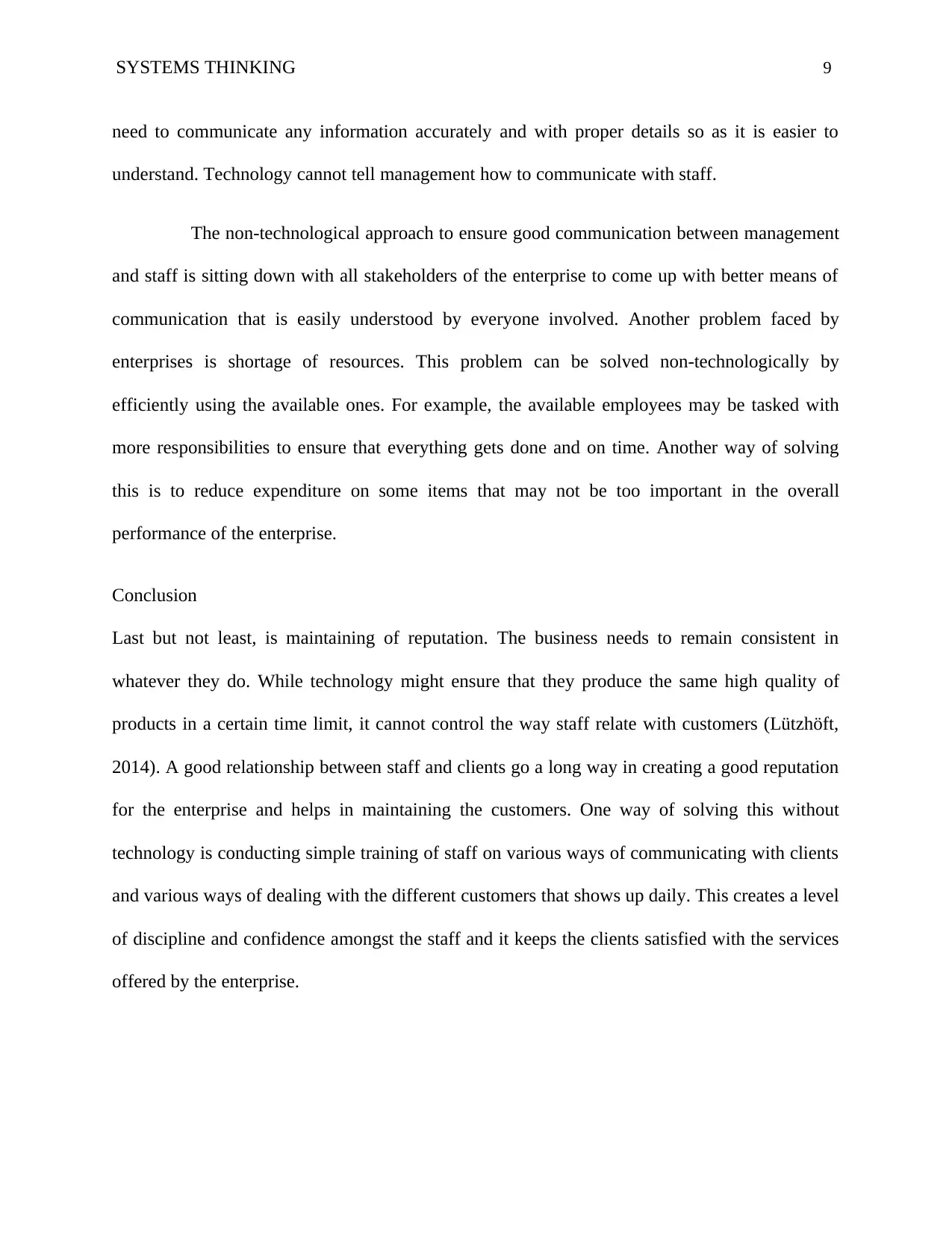
SYSTEMS THINKING 9
need to communicate any information accurately and with proper details so as it is easier to
understand. Technology cannot tell management how to communicate with staff.
The non-technological approach to ensure good communication between management
and staff is sitting down with all stakeholders of the enterprise to come up with better means of
communication that is easily understood by everyone involved. Another problem faced by
enterprises is shortage of resources. This problem can be solved non-technologically by
efficiently using the available ones. For example, the available employees may be tasked with
more responsibilities to ensure that everything gets done and on time. Another way of solving
this is to reduce expenditure on some items that may not be too important in the overall
performance of the enterprise.
Conclusion
Last but not least, is maintaining of reputation. The business needs to remain consistent in
whatever they do. While technology might ensure that they produce the same high quality of
products in a certain time limit, it cannot control the way staff relate with customers (Lützhöft,
2014). A good relationship between staff and clients go a long way in creating a good reputation
for the enterprise and helps in maintaining the customers. One way of solving this without
technology is conducting simple training of staff on various ways of communicating with clients
and various ways of dealing with the different customers that shows up daily. This creates a level
of discipline and confidence amongst the staff and it keeps the clients satisfied with the services
offered by the enterprise.
need to communicate any information accurately and with proper details so as it is easier to
understand. Technology cannot tell management how to communicate with staff.
The non-technological approach to ensure good communication between management
and staff is sitting down with all stakeholders of the enterprise to come up with better means of
communication that is easily understood by everyone involved. Another problem faced by
enterprises is shortage of resources. This problem can be solved non-technologically by
efficiently using the available ones. For example, the available employees may be tasked with
more responsibilities to ensure that everything gets done and on time. Another way of solving
this is to reduce expenditure on some items that may not be too important in the overall
performance of the enterprise.
Conclusion
Last but not least, is maintaining of reputation. The business needs to remain consistent in
whatever they do. While technology might ensure that they produce the same high quality of
products in a certain time limit, it cannot control the way staff relate with customers (Lützhöft,
2014). A good relationship between staff and clients go a long way in creating a good reputation
for the enterprise and helps in maintaining the customers. One way of solving this without
technology is conducting simple training of staff on various ways of communicating with clients
and various ways of dealing with the different customers that shows up daily. This creates a level
of discipline and confidence amongst the staff and it keeps the clients satisfied with the services
offered by the enterprise.
⊘ This is a preview!⊘
Do you want full access?
Subscribe today to unlock all pages.

Trusted by 1+ million students worldwide
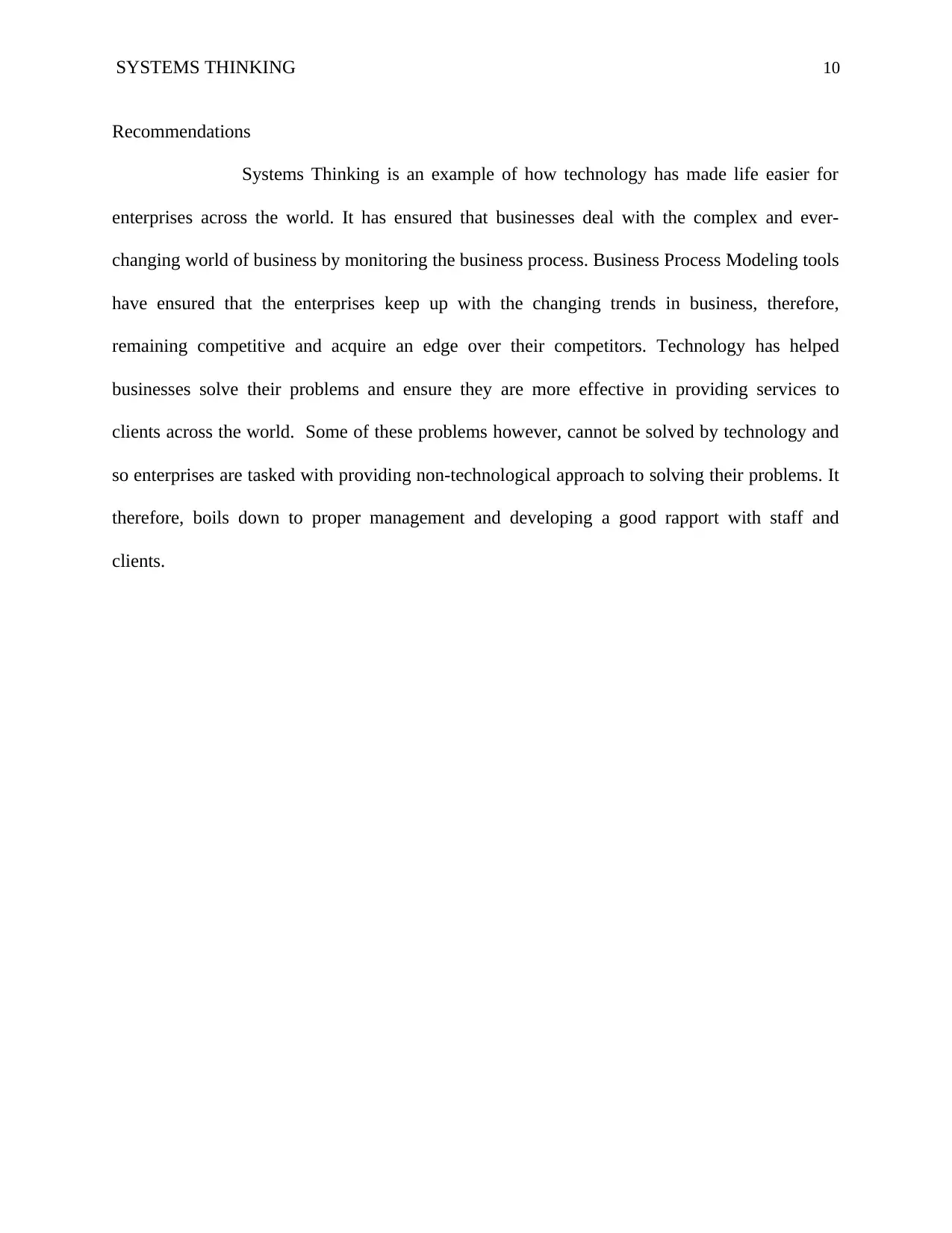
SYSTEMS THINKING 10
Recommendations
Systems Thinking is an example of how technology has made life easier for
enterprises across the world. It has ensured that businesses deal with the complex and ever-
changing world of business by monitoring the business process. Business Process Modeling tools
have ensured that the enterprises keep up with the changing trends in business, therefore,
remaining competitive and acquire an edge over their competitors. Technology has helped
businesses solve their problems and ensure they are more effective in providing services to
clients across the world. Some of these problems however, cannot be solved by technology and
so enterprises are tasked with providing non-technological approach to solving their problems. It
therefore, boils down to proper management and developing a good rapport with staff and
clients.
Recommendations
Systems Thinking is an example of how technology has made life easier for
enterprises across the world. It has ensured that businesses deal with the complex and ever-
changing world of business by monitoring the business process. Business Process Modeling tools
have ensured that the enterprises keep up with the changing trends in business, therefore,
remaining competitive and acquire an edge over their competitors. Technology has helped
businesses solve their problems and ensure they are more effective in providing services to
clients across the world. Some of these problems however, cannot be solved by technology and
so enterprises are tasked with providing non-technological approach to solving their problems. It
therefore, boils down to proper management and developing a good rapport with staff and
clients.
Paraphrase This Document
Need a fresh take? Get an instant paraphrase of this document with our AI Paraphraser
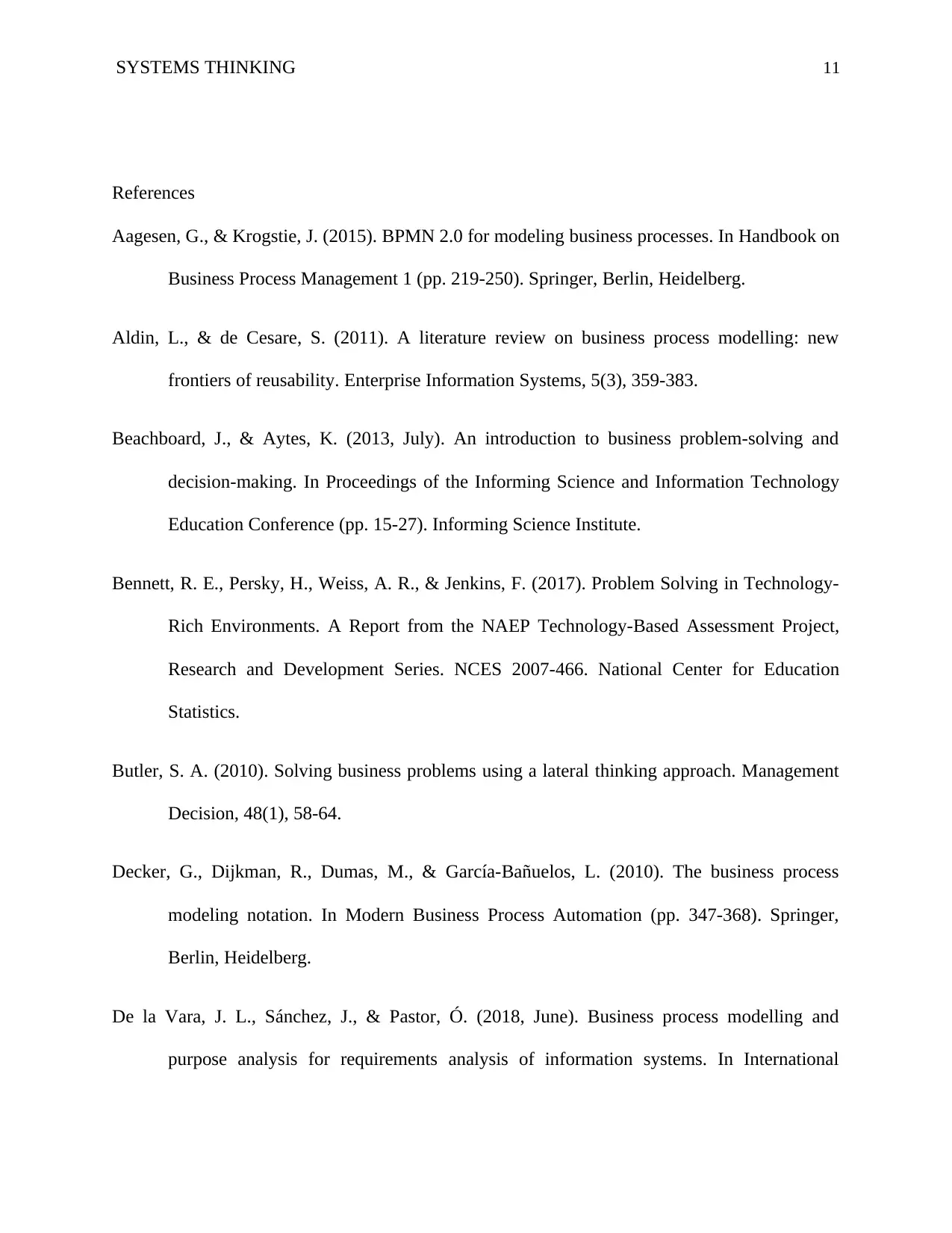
SYSTEMS THINKING 11
References
Aagesen, G., & Krogstie, J. (2015). BPMN 2.0 for modeling business processes. In Handbook on
Business Process Management 1 (pp. 219-250). Springer, Berlin, Heidelberg.
Aldin, L., & de Cesare, S. (2011). A literature review on business process modelling: new
frontiers of reusability. Enterprise Information Systems, 5(3), 359-383.
Beachboard, J., & Aytes, K. (2013, July). An introduction to business problem-solving and
decision-making. In Proceedings of the Informing Science and Information Technology
Education Conference (pp. 15-27). Informing Science Institute.
Bennett, R. E., Persky, H., Weiss, A. R., & Jenkins, F. (2017). Problem Solving in Technology-
Rich Environments. A Report from the NAEP Technology-Based Assessment Project,
Research and Development Series. NCES 2007-466. National Center for Education
Statistics.
Butler, S. A. (2010). Solving business problems using a lateral thinking approach. Management
Decision, 48(1), 58-64.
Decker, G., Dijkman, R., Dumas, M., & García-Bañuelos, L. (2010). The business process
modeling notation. In Modern Business Process Automation (pp. 347-368). Springer,
Berlin, Heidelberg.
De la Vara, J. L., Sánchez, J., & Pastor, Ó. (2018, June). Business process modelling and
purpose analysis for requirements analysis of information systems. In International
References
Aagesen, G., & Krogstie, J. (2015). BPMN 2.0 for modeling business processes. In Handbook on
Business Process Management 1 (pp. 219-250). Springer, Berlin, Heidelberg.
Aldin, L., & de Cesare, S. (2011). A literature review on business process modelling: new
frontiers of reusability. Enterprise Information Systems, 5(3), 359-383.
Beachboard, J., & Aytes, K. (2013, July). An introduction to business problem-solving and
decision-making. In Proceedings of the Informing Science and Information Technology
Education Conference (pp. 15-27). Informing Science Institute.
Bennett, R. E., Persky, H., Weiss, A. R., & Jenkins, F. (2017). Problem Solving in Technology-
Rich Environments. A Report from the NAEP Technology-Based Assessment Project,
Research and Development Series. NCES 2007-466. National Center for Education
Statistics.
Butler, S. A. (2010). Solving business problems using a lateral thinking approach. Management
Decision, 48(1), 58-64.
Decker, G., Dijkman, R., Dumas, M., & García-Bañuelos, L. (2010). The business process
modeling notation. In Modern Business Process Automation (pp. 347-368). Springer,
Berlin, Heidelberg.
De la Vara, J. L., Sánchez, J., & Pastor, Ó. (2018, June). Business process modelling and
purpose analysis for requirements analysis of information systems. In International
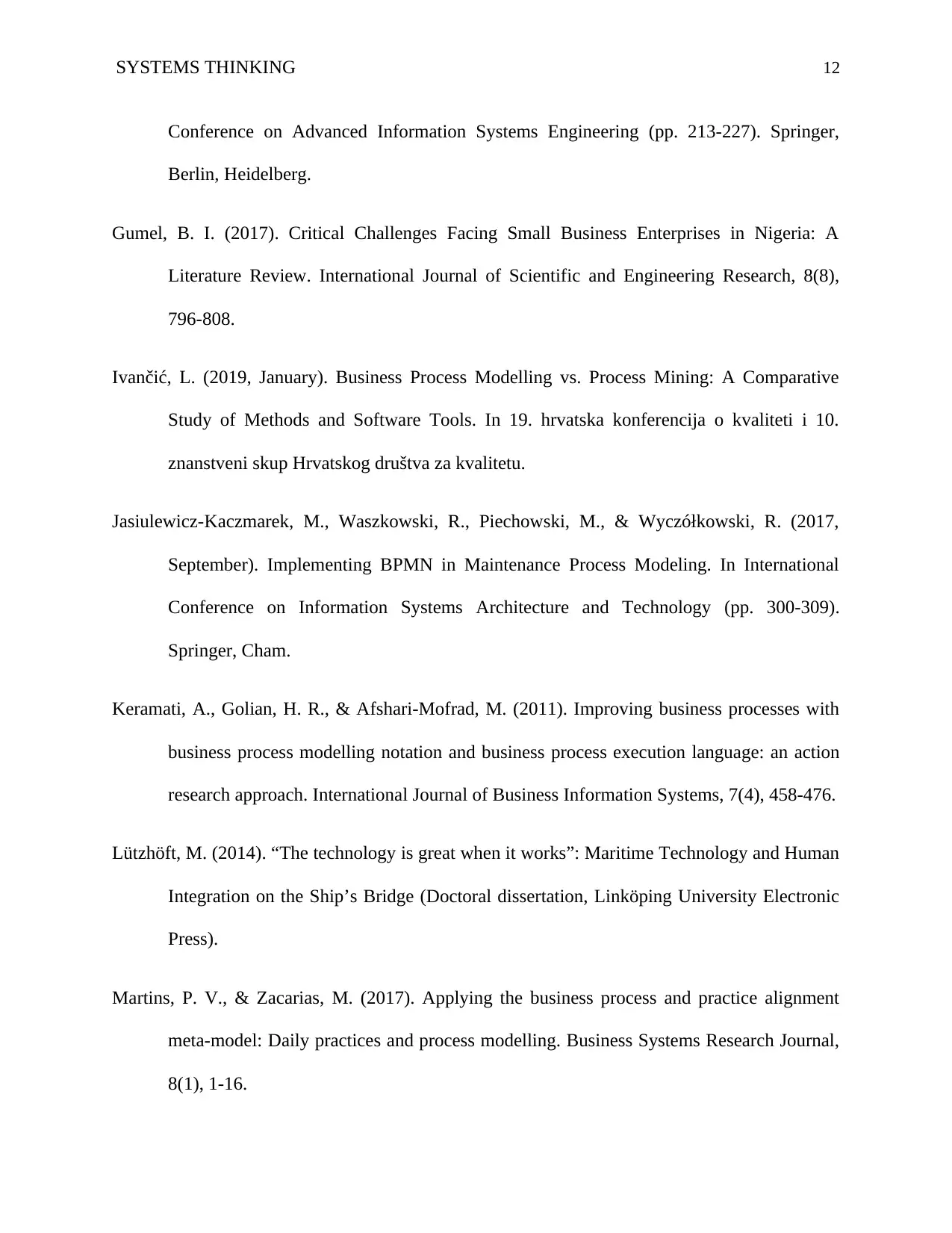
SYSTEMS THINKING 12
Conference on Advanced Information Systems Engineering (pp. 213-227). Springer,
Berlin, Heidelberg.
Gumel, B. I. (2017). Critical Challenges Facing Small Business Enterprises in Nigeria: A
Literature Review. International Journal of Scientific and Engineering Research, 8(8),
796-808.
Ivančić, L. (2019, January). Business Process Modelling vs. Process Mining: A Comparative
Study of Methods and Software Tools. In 19. hrvatska konferencija o kvaliteti i 10.
znanstveni skup Hrvatskog društva za kvalitetu.
Jasiulewicz-Kaczmarek, M., Waszkowski, R., Piechowski, M., & Wyczółkowski, R. (2017,
September). Implementing BPMN in Maintenance Process Modeling. In International
Conference on Information Systems Architecture and Technology (pp. 300-309).
Springer, Cham.
Keramati, A., Golian, H. R., & Afshari-Mofrad, M. (2011). Improving business processes with
business process modelling notation and business process execution language: an action
research approach. International Journal of Business Information Systems, 7(4), 458-476.
Lützhöft, M. (2014). “The technology is great when it works”: Maritime Technology and Human
Integration on the Ship’s Bridge (Doctoral dissertation, Linköping University Electronic
Press).
Martins, P. V., & Zacarias, M. (2017). Applying the business process and practice alignment
meta-model: Daily practices and process modelling. Business Systems Research Journal,
8(1), 1-16.
Conference on Advanced Information Systems Engineering (pp. 213-227). Springer,
Berlin, Heidelberg.
Gumel, B. I. (2017). Critical Challenges Facing Small Business Enterprises in Nigeria: A
Literature Review. International Journal of Scientific and Engineering Research, 8(8),
796-808.
Ivančić, L. (2019, January). Business Process Modelling vs. Process Mining: A Comparative
Study of Methods and Software Tools. In 19. hrvatska konferencija o kvaliteti i 10.
znanstveni skup Hrvatskog društva za kvalitetu.
Jasiulewicz-Kaczmarek, M., Waszkowski, R., Piechowski, M., & Wyczółkowski, R. (2017,
September). Implementing BPMN in Maintenance Process Modeling. In International
Conference on Information Systems Architecture and Technology (pp. 300-309).
Springer, Cham.
Keramati, A., Golian, H. R., & Afshari-Mofrad, M. (2011). Improving business processes with
business process modelling notation and business process execution language: an action
research approach. International Journal of Business Information Systems, 7(4), 458-476.
Lützhöft, M. (2014). “The technology is great when it works”: Maritime Technology and Human
Integration on the Ship’s Bridge (Doctoral dissertation, Linköping University Electronic
Press).
Martins, P. V., & Zacarias, M. (2017). Applying the business process and practice alignment
meta-model: Daily practices and process modelling. Business Systems Research Journal,
8(1), 1-16.
⊘ This is a preview!⊘
Do you want full access?
Subscribe today to unlock all pages.

Trusted by 1+ million students worldwide
1 out of 13
Related Documents
Your All-in-One AI-Powered Toolkit for Academic Success.
+13062052269
info@desklib.com
Available 24*7 on WhatsApp / Email
![[object Object]](/_next/static/media/star-bottom.7253800d.svg)
Unlock your academic potential
Copyright © 2020–2025 A2Z Services. All Rights Reserved. Developed and managed by ZUCOL.





